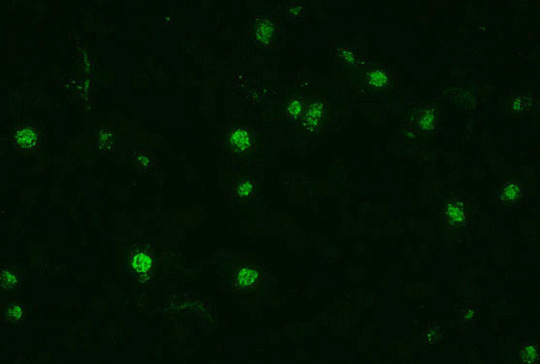 |
Indirect Fluorescent Antibody Test
Malaria antibody detection is performed using the indirect fluorescent
antibody (IFA) test. The IFA procedure can be used to determine if a
patient has been infected with Plasmodium . Because of the time
required for development of antibody and also the persistence of antibodies,
serologic testing is not practical for routine diagnosis of acute malaria.
However, antibody detection may be useful for:
- Screening blood donors involved in cases of transfusion-induced
malaria when the donor's parasitemia may be below the detectable level
of blood film examination
- Testing a patient with a febrile illness who is suspected
of having malaria and from whom repeated blood smears are negative
- Testing a patient who has been recently treated for malaria
but in whom the diagnosis is questioned.
Species-specific testing is available for the four human species: P.
falciparum , P. vivax , P. malariae , and P.
ovale . Cross reactions often occur between Plasmodium species
and Babesia species. Blood stage Plasmodium species
schizonts (meronts) are used as antigen. The patient's serum is exposed
to the organisms; homologous antibody, if present, attaches to the
antigen, forming an antigen-antibody (Ag-Ab) complex. Fluorescein-labeled
anti-human antibody is then added, which attaches to the patient's
malaria-specific antibodies. When examined with a fluorescence microscope,
a positive reaction is when the parasites fluoresce an apple green
color.
Enzyme immunoassays have also been employed as a tool to screen blood
donors, but have limited sensitivity due to use of only Plasmodium falciparium antigen
instead of antigens of all four human species.
 |
| Indirect fluorescent antibody (IFA) test. The fluorescence indicates
that the patient serum being tested contains antibodies that are
reacting with the antigen preparation (here, Plasmodium falciparum parasites). |
 See
Also: Usefulness of Antibody Detection in the Diagnosis of Malaria Parasites slide
set See
Also: Usefulness of Antibody Detection in the Diagnosis of Malaria Parasites slide
set
Download
PowerPoint version  (5.79 MB) (5.79 MB)
Page last modified : April 23, 2004
Content source: Division of Parasitic Diseases
National Center for Zoonotic, Vector-Borne, and Enteric Diseases (ZVED)
|
 |
|



